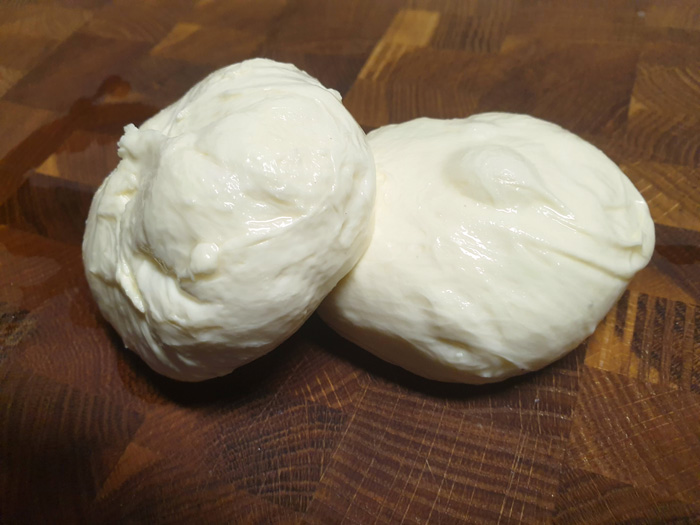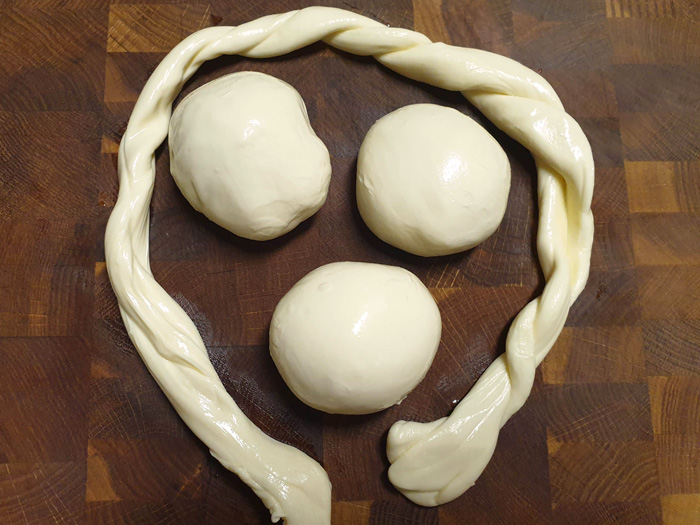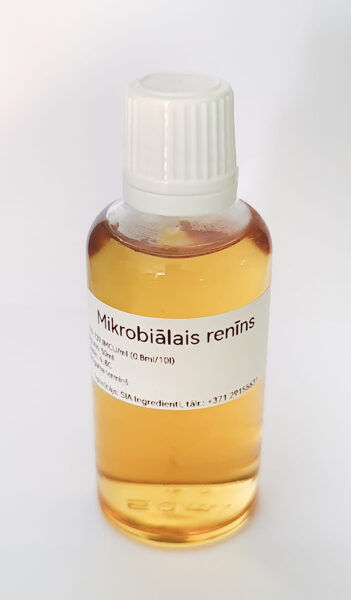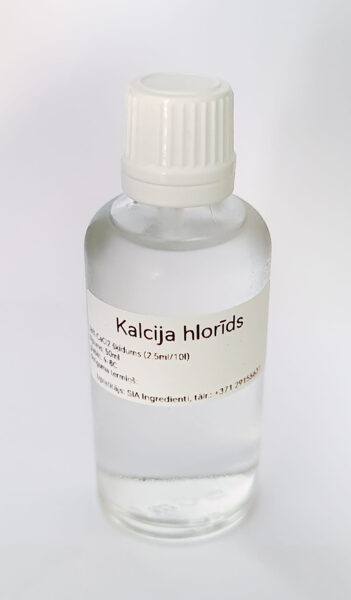Mozzarella cheese recipe with citric acid
(quick recipe)
Required:
- Milk
- Citric acid
- Rennet (0.85ml/10l milk)
- Calcium chloride (2.5ml/10l milk)
Recipe
- Pasteurize the milk. Heat the milk to 65°C and keep it for 30 minutes. Or 70°C for 15 minutes.
- Quickly cool the milk by placing it in a clean sink, bowl, or bath with cold water.
- Pour cooled milk (not warmer than 13°C) into the pot.
- Dilute citric acid in 50ml of water at room temperature. Stir thoroughly until the citric acid is completely dissolved. The amount of citric acid depends on the acidity of milk, fat content, season, and other factors. The recommended amount is 1.8 grams per liter of milk.
- Slowly, pour the diluted citric acid into the milk, while stirring.
- Heat the milk to 33°C.
- If the milk is pasteurized, which is recommended even for milk from your own farm, then Calcium chloride (CaCl2) should be added, which should be diluted in 50ml of water and slowly added to the milk while stirring. During pasteurization, CaCl2 rapidly decreases in milk, which inhibits the coagulation process (thickening of milk). If the milk is not pasteurized, then CaCl2 may not be added.
- Dilute rennet (can be purchased in the e-store) in 50ml of warm water (30–35 °C). The dose depends on the enzyme used, the acidity of the milk, and other factors. With the microbial enzyme offered in the e-store, 1-2 drops per 1 liter of milk should be enough. The coagulation time should be 10 minutes. If it thickens faster, add less enzyme next time; if it thickens later, add more enzyme. The coagulation enzyme must be added to the milk slowly, stirring the milk constantly and thoroughly for 30 seconds.
- Flocculation multiplier is 3. That means that if the milk has thickened (forms a curd) within 12 minutes, you can move on to the next stage only after 36 minutes (12x3 = 36 minutes). If the milk has thickened only after 20 minutes, then 20*3 = 60 minutes, and the milk should be left aside for 60 minutes and then you can cut the curd.
- Cut the thickened milk curd in large cubes of 5-7 cm. (gradually, the whey starts to come out).
- Slice vertically into bars and leave on for 5 minutes.
- Cut horizontally using special knives or homemade knives from wires or skewers, which are folded in the form of "L" shape. Leave for 5 minutes.
- Stir very slowly and carefully so as not to break the structure.
- Wait 5 minutes and then stir.
- In the 15 minutes, heat the milk to 40°C while stirring continuously. Then remove it from the heat.
- Pour out the whey and form the cheese mass. The whey will be also separated.
- Cut the cheese mass into small pieces (about 5 cm), put it back in the pot, and sprinkle the iodine-free salt 5-10gr/1l milk
- Heat the water in a kettle (or elsewhere) to 68–72 °C and place a bowl of cold water next to it.
- Do the stretching test: take a little cheese mass and put it inside the hot water for 10-60 sec. The mass should stretch immediately (use thick gloves as the water is hot). If it stretches, then we directly go to the 21st point.
- If the cheese mass does not stretch, you have to wait until it reaches the required acidity level at room temperature or slightly warmer (you can put a towel on it so that the temperature does not decrease). Next time, you can put a little more citric acid to avoid so long wait.
- Stretch the cheese. Pour hot water at 68-72°C into the pot with the cut cheese mass, wait a little, and start stretching the cheese mass with a wooden shovel, helping with your hands.
- Don't stretch too much, because then the cheese will be hard. A couple of times is enough. If you need hard mozzarella, you can stretch it even longer.
- Make mozzarella balls by squeezing the cheese mass through a clenched fist or make any other shape (e.g. cheese sticks).
 Put the finished cheese mass in cold water.
Put the finished cheese mass in cold water.- After cooling, you can transfer it to another place or put it in slightly salted water.
- For such mozzarella, the shelf life is 1-2 days when stored in the refrigerator.
Useful:
- Coagulation. If nothing has happened to the milk after 20 minutes, add the same amount of enzyme. But if the consistency becomes thicker, then you don't need to add anything; just wait, but next time add more rennet. For a successful coagulation process, it is important that, after milking, the milk remain in the refrigerator for at least 12 hours to complete the bactericidal phase. The bactericidal phase is influenced by several factors: how quickly the milk was cooled after milking, at what temperature it was stored, the amount of microorganisms, and the individual characteristics of the animals.
If the cheese does not stretch immediately but is fragile, it means that the acidity has not yet been reached. You have to wait for the level of acidity to be reached, checking every 20 minutes.
If the cheese mass melts too much in hot water, then you have added too much citric acid or the water is too hot. It should not be hotter than 80°C.
To extend the cheese's storage time, it is recommended to use special cultures (bacteria) that should be added instead of citric acid.
We look forward to your feedback!


